AnandTech Guide to Better Photos: Night Photography
by Stephen Caston on February 18, 2005 12:05 AM EST- Posted in
- Digital Camera
Capturing Motion
One of the great things about night photography is using long exposures to create interesting effects. By exposing a scene for a couple seconds or more, you can capture images that we cannot see with our naked eyes. One of the most commonly-used ways to exploit this phenomenon is by taking long exposures of moving cars.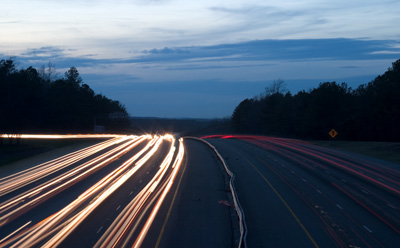
(10 sec., f/25, ISO 100)
Click to enlarge.
In the example above, we took a 10-second exposure while standing on an overpass above I-40. By taking the picture just after the sun went down, we were able to capture some detail in the sky.
If you ever get bored, another cool thing to do is to face your camera towards you. Set the camera to a long exposure and step back several feet. Then, use a flashlight, lighter, etc. to "draw" in the air. Check the results and tweak the aperture setting until you can get good clean results. There are people such as Tokihiro Sato who have turned this into an interesting form of photo art. We highly recommend experimenting with this because there are a lot of really creative things that you can do.
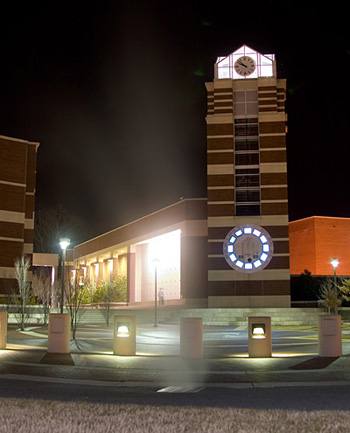
(10 sec, f/5.6, ISO 100)
Click to enlarge.
When you are looking for good, long exposure opportunities, keep an eye out for any kind of movement. The results can make your images seem a bit unreal. In the example above, the steam coming from the grate in the bottom center of the frame adds a mystical quality to the image. Over the course of the 10-second exposure, the steam created the effect of a ghostly figure rising from the ground.
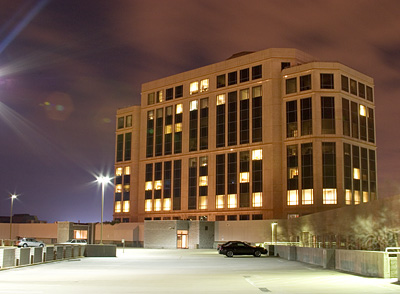
(30 sec., f/16, ISO 400)
Click to enlarge.
In the picture above, the clouds were moving at a slow pace. After exposing the frame for 30 seconds, the clouds smoothed out creating a soft surreal effect (it almost looks like a parallax sky from Duke3d). If we had exposed this image for much longer, the detail in the clouds would have been lost.
Photographing the night sky is something that can be very rewarding, but it requires a lot of patience. Of course, you will want to use your camera's lowest ISO setting and experiment with different exposure times. However, one of the biggest problems with taking pictures of the sky is light pollution. Light pollution is most frequently caused by city lights shining into the sky. The result is that your sky images are going to be very bright when they are exposed for a long period of time. Below is an example
| Light Pollution |
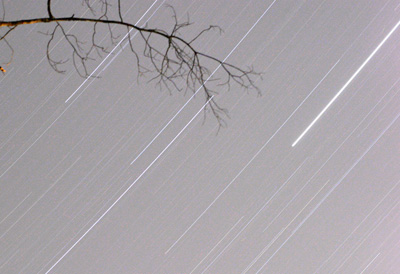 (60 min., f/5.6, ISO 100) Click to enlarge. |
In the picture above, our star image suffers from strong light pollution even though the sky looked pitch black and we were 30 miles from Raleigh, NC in a fairly rural town. If you are looking to capture anything in the sky with a long exposure, make sure that you are very far from any major cities or other sources of light pollution.
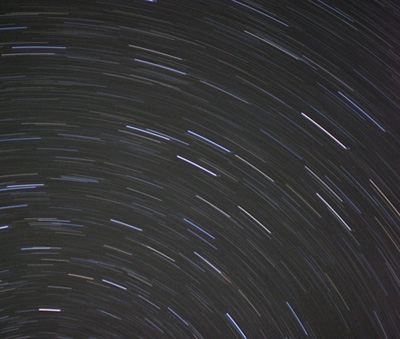
(30 min., f/2.5, ISO 100)
Click to enlarge.
In the example above, we found ourselves far from civilization in the wilderness of Maine. With a 30-minute exposure, we were able to capture an interesting pattern of movement.
We hope that this guide has inspired you to experiment with the fun of night photography. If you have tried before and the results weren't as good as you had expected, don't give up. Just keep an eye on your settings and shoot in several different locations. Night photography is no different from any other kind of photography in the sense that there seems to be no end to the possibilities. Once you have the technique down, the hardest part is to use your creativity to see beyond what is in front of your eyes. A long exposure can create interesting and dramatic effects with a seemingly "normal" subject. Good luck and the next time you have the urge to take pictures, don't let the night stop you!










20 Comments
View All Comments
sxr7171 - Saturday, February 19, 2005 - link
You can find upto 30 secs on all the Canon S and SD series point and shoot digital cameras.AtaStrumf - Saturday, February 19, 2005 - link
That flashlight trick is realy neat. You can also use a flashlight to illuminate just parts of the scene or to outline certain objects like cars and stuff.Night and dusk photos are great fun to do, but the problem that I have is picking the best digicam (not DSLR) for long exposures. As far as I have seen FUJI seems to be the best in terms of noise, but I really don't know for sure. Exposures longer that a few seconds are also not that easy to find in a compact digicam. And then there's the problem of apertures, ...
Suggestions anyone?
Jeff7181 - Friday, February 18, 2005 - link
Maybe a "choosing a digital camera" article would be a good addition to the series? Explain the features... include photos take with different features. That's what I've always looked for but never found when shopping for a digital camera. Sure, a 5 MP camera will take a more detailed photo than a 3 MP camera... but how MUCH more detailed? Would it matter to me? Stuff like that is hard to find answers to unless you can take two cameras side by side, shoot the picture, and examine the results yourself.shuttleboi - Friday, February 18, 2005 - link
Good article, but you fail to mention the importance of the digital camera's sensor size. The Canon 10D that you have (as well as my 300D) has an APS-C size sensor, much larger than those found in point-and-shoot digital cameras, resulting in MUCH less grain and noise during night shots. If you are shooting with high ISO, then the grain will be unacceptable. Long-exposure shots will also have pretty bad grain.shuttleboi - Friday, February 18, 2005 - link
How about reviewing the Epson P-2000 and the Archos AV400 as digital storage devices, like I've been suggesting the last 7 months?Vinney - Friday, February 18, 2005 - link
steve - awesome article, esp. because i've been waiting to do some shots similar to the cars on I-40 .. now i have no more excuses to delay.. (well except for all the ones i keep telling myself)Poser - Friday, February 18, 2005 - link
Thought it might be worth mentioning the open source photoshop imitator, GIMP here. Windows binaries are available, and it provides a zero cost way of doing many of the things photoshop can do.http://www.gimp.org
Jeff7181 - Friday, February 18, 2005 - link
Ok... gotcha... I didn't mean RIGHT under the lense, but wasn't sure if the ideas was to heat/light the air just in front of the lense or what. I understand now, thanks.HauntFox - Friday, February 18, 2005 - link
This is just what I needed, I been wanting to take some night photos :Dstephencaston - Friday, February 18, 2005 - link
Please don't hold a lighter under your lens! :-) The idea is to stand several feet in front of your camera and use a flashlight or lighter to "draw" in the air. This light will be recorded by the camera and can look really cool. A flashlight doesn't necessarily have to be pointed directly into the lens; pointing the light somewhere in the direction of the camera will work. Pointing the light directly at the lens will create a lens flare effect if thats what you want. There really are no rules for this type of thing, but its a fun creative way to paint with light. I hope this helps to clarify.